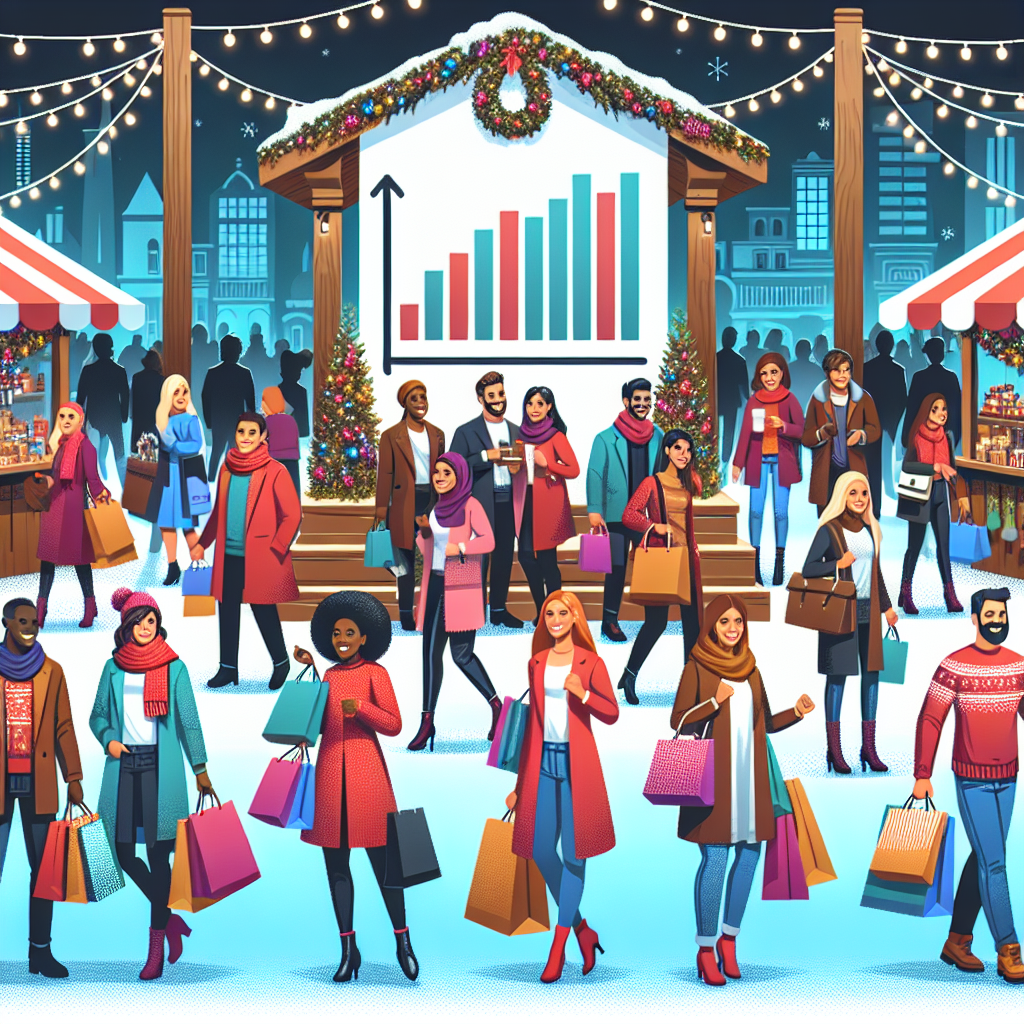“Holiday Cheer: Americans Set to Spend Big This Season!”
Introduction
Title: Experts Predict Increased Holiday Spending by Americans
As the holiday season approaches, economic analysts and market experts are forecasting a significant uptick in consumer spending across the United States. This anticipated surge in holiday expenditures is attributed to a combination of factors, including improved economic conditions, increased consumer confidence, and a strong labor market. Retailers are gearing up for a bustling season, with many expanding their inventories and enhancing their online shopping platforms to accommodate the expected rise in demand. Additionally, the easing of pandemic-related restrictions has reignited enthusiasm for in-person shopping experiences, further contributing to the optimistic outlook for holiday sales. As Americans prepare to celebrate the festive season, the anticipated increase in spending is poised to provide a substantial boost to the economy, benefiting businesses and consumers alike.
Economic Factors Driving Increased Holiday Spending
As the holiday season approaches, economic analysts are forecasting a notable increase in holiday spending by Americans, driven by a confluence of economic factors that are shaping consumer behavior. This anticipated rise in expenditure is not merely a reflection of seasonal enthusiasm but is underpinned by several key economic indicators that suggest a robust consumer confidence and a resilient economy. To understand this phenomenon, it is essential to examine the various elements contributing to this projected increase in holiday spending.
Firstly, the labor market has shown remarkable strength, with unemployment rates remaining at historically low levels. This stability in employment has provided consumers with a sense of financial security, encouraging them to spend more freely during the holiday season. Moreover, wage growth, albeit modest, has been consistent, allowing households to have a bit more disposable income. This increase in disposable income is a critical factor, as it directly influences the purchasing power of consumers, enabling them to allocate more funds towards holiday-related expenses.
In addition to the favorable employment landscape, consumer confidence indices have been trending upwards. These indices, which measure the overall economic optimism of households, suggest that Americans are feeling more positive about their financial prospects. This optimism is often translated into increased spending, as consumers are more likely to indulge in discretionary purchases when they feel confident about their economic future. Consequently, this heightened consumer confidence is expected to play a significant role in driving holiday spending.
Furthermore, the easing of inflationary pressures has also contributed to the anticipated increase in holiday expenditures. Over the past year, inflation rates have shown signs of stabilization, which has alleviated some of the financial strain on consumers. With prices of goods and services becoming more predictable, consumers are less hesitant to spend, knowing that their purchasing power is not being eroded as rapidly as it was during periods of high inflation. This stabilization has provided a conducive environment for increased spending, particularly during the holiday season when consumer demand typically peaks.
Another factor contributing to the expected rise in holiday spending is the evolution of retail strategies. Retailers have become increasingly adept at leveraging technology and data analytics to tailor their marketing efforts, offering personalized promotions and discounts that resonate with consumers. These targeted marketing strategies, coupled with the convenience of online shopping, have made it easier for consumers to make purchases, thereby boosting overall spending. The seamless integration of digital and physical retail experiences has also played a role in enhancing consumer engagement, further driving holiday sales.
Moreover, the cultural significance of the holiday season cannot be overlooked. For many Americans, the holidays represent a time of celebration and generosity, prompting them to spend on gifts, travel, and entertainment. This cultural inclination towards spending during the holidays is deeply ingrained and continues to be a driving force behind the seasonal surge in consumer activity.
In conclusion, the projected increase in holiday spending by Americans is a multifaceted phenomenon influenced by a combination of economic stability, consumer confidence, inflationary trends, retail innovations, and cultural factors. As these elements converge, they create an environment conducive to heightened consumer activity, setting the stage for a robust holiday shopping season. As such, businesses and policymakers alike will be closely monitoring these trends, recognizing the significant impact that holiday spending has on the broader economy.
Impact of Consumer Confidence on Holiday Purchases
As the holiday season approaches, experts are forecasting a notable increase in holiday spending by Americans, driven largely by heightened consumer confidence. This anticipated surge in expenditure is not merely a reflection of seasonal enthusiasm but is deeply rooted in the broader economic landscape and consumer sentiment. Understanding the dynamics of consumer confidence provides valuable insights into how it influences holiday purchases and the overall economic environment.
Consumer confidence, a key economic indicator, reflects the degree of optimism that consumers feel about the overall state of the economy and their personal financial situation. When confidence is high, consumers are more likely to spend money, particularly on non-essential items such as holiday gifts, travel, and entertainment. This year, several factors have contributed to a boost in consumer confidence, thereby setting the stage for increased holiday spending.
One of the primary drivers of this optimism is the steady improvement in the labor market. With unemployment rates remaining low and job creation on the rise, more Americans feel secure in their employment and are therefore more willing to open their wallets. Additionally, wage growth, although modest, has provided consumers with a bit more disposable income, further encouraging spending. This financial stability allows consumers to plan for more generous holiday budgets, translating into higher sales for retailers.
Moreover, the easing of inflationary pressures has also played a significant role in bolstering consumer confidence. Over the past year, inflation rates have shown signs of stabilizing, alleviating some of the financial strain on households. As prices for goods and services become more predictable, consumers are less hesitant to make purchases, particularly those that are discretionary in nature. This newfound predictability in pricing has allowed consumers to plan their holiday shopping with greater certainty, contributing to the anticipated rise in spending.
In addition to economic factors, the psychological aspect of consumer behavior cannot be overlooked. The holiday season is traditionally a time of joy and generosity, and after several years of pandemic-related disruptions, many Americans are eager to return to pre-pandemic holiday traditions. This desire to reconnect with loved ones and celebrate in a more traditional manner is expected to drive spending on travel, dining, and entertainment, in addition to gift-giving.
Retailers, aware of these trends, are preparing to meet the increased demand by offering a variety of promotions and discounts to attract consumers. The strategic use of marketing campaigns, both online and in-store, aims to capitalize on the positive consumer sentiment and encourage even more spending. Furthermore, advancements in e-commerce and the convenience of online shopping have made it easier for consumers to make purchases, thereby contributing to the overall increase in holiday spending.
In conclusion, the interplay between consumer confidence and holiday spending is a complex but crucial aspect of the economic landscape. As Americans feel more optimistic about their financial situations and the broader economy, they are more inclined to spend during the holiday season. This increased expenditure not only benefits retailers but also has a ripple effect on the economy, driving growth and creating a positive feedback loop. As we move into the holiday season, the heightened consumer confidence is expected to translate into robust holiday sales, marking a significant shift from the cautious spending patterns observed in recent years.
Retail Strategies to Capture Holiday Shoppers
As the holiday season approaches, retailers are gearing up for what experts predict will be a period of increased spending by American consumers. This anticipated surge in holiday shopping presents both opportunities and challenges for businesses aiming to capture the attention and wallets of eager shoppers. To effectively capitalize on this trend, retailers are employing a variety of strategies designed to enhance the shopping experience, both in-store and online, while also ensuring they meet the evolving expectations of consumers.
One of the primary strategies being adopted by retailers is the enhancement of their digital presence. With the rise of e-commerce, consumers have become accustomed to the convenience of online shopping, and this trend is expected to continue during the holiday season. Retailers are investing in user-friendly websites and mobile apps that offer seamless navigation, personalized recommendations, and secure payment options. By optimizing their digital platforms, businesses aim to provide a hassle-free shopping experience that encourages consumers to make purchases from the comfort of their homes.
In addition to bolstering their online presence, retailers are also focusing on creating memorable in-store experiences. Despite the growth of e-commerce, many consumers still value the tactile experience of shopping in physical stores. To attract these shoppers, retailers are designing visually appealing store layouts, offering exclusive in-store promotions, and hosting special events that create a festive atmosphere. By providing an engaging and enjoyable shopping environment, retailers hope to entice consumers to visit their stores and make purchases.
Moreover, retailers are increasingly leveraging data analytics to better understand consumer behavior and preferences. By analyzing purchasing patterns and customer feedback, businesses can tailor their marketing strategies to target specific demographics and offer personalized promotions. This data-driven approach allows retailers to anticipate consumer needs and deliver relevant offers that resonate with shoppers, ultimately driving sales during the holiday season.
Another critical aspect of capturing holiday shoppers is ensuring efficient supply chain management. With increased demand comes the challenge of maintaining adequate inventory levels and timely delivery of products. Retailers are investing in advanced logistics solutions and collaborating with suppliers to streamline their supply chains. By doing so, they aim to minimize disruptions and ensure that popular items are readily available, thereby preventing potential loss of sales due to stockouts.
Furthermore, retailers are placing a strong emphasis on customer service as a means of differentiating themselves from competitors. During the holiday season, when consumers are often stressed and pressed for time, exceptional customer service can significantly enhance the shopping experience. Retailers are training their staff to be knowledgeable, courteous, and responsive to customer inquiries, both in-store and online. By providing superior customer service, businesses can build trust and loyalty, encouraging repeat purchases and positive word-of-mouth referrals.
In conclusion, as experts predict increased holiday spending by Americans, retailers are implementing a range of strategies to capture the attention of holiday shoppers. By enhancing their digital presence, creating engaging in-store experiences, leveraging data analytics, optimizing supply chain management, and prioritizing customer service, businesses are well-positioned to capitalize on the anticipated surge in consumer spending. As the holiday season unfolds, these strategies will play a crucial role in helping retailers achieve their sales goals and ensure a successful end to the year.
The Role of E-commerce in Holiday Spending Trends

As the holiday season approaches, experts are forecasting a significant increase in holiday spending by Americans, with e-commerce playing a pivotal role in shaping these trends. The convenience and accessibility of online shopping have transformed consumer behavior, making it a dominant force in the retail landscape. This shift is not only influencing how consumers shop but also how retailers strategize to capture a larger share of the holiday market.
To begin with, the rise of e-commerce has been fueled by technological advancements and changing consumer preferences. The proliferation of smartphones and high-speed internet has made online shopping more accessible than ever before. Consumers are increasingly drawn to the convenience of browsing and purchasing products from the comfort of their homes, avoiding the crowds and long lines typically associated with brick-and-mortar stores during the holiday rush. Moreover, the ability to compare prices and read reviews online empowers consumers to make more informed purchasing decisions, further driving the appeal of e-commerce.
In addition to convenience, the variety and availability of products online are unparalleled. E-commerce platforms offer an extensive range of goods, from electronics and fashion to niche products that may not be readily available in physical stores. This vast selection allows consumers to find unique gifts for their loved ones, contributing to increased spending during the holiday season. Furthermore, online retailers often provide exclusive deals and discounts, enticing consumers to spend more as they seek to maximize their savings.
Another factor contributing to the surge in e-commerce holiday spending is the growing importance of digital marketing. Retailers are leveraging data analytics and targeted advertising to reach potential customers more effectively. Personalized marketing campaigns, which utilize consumer data to tailor advertisements to individual preferences, have proven to be highly effective in driving sales. As a result, consumers are more likely to encounter products that align with their interests, increasing the likelihood of impulse purchases and higher overall spending.
Moreover, the integration of social media and e-commerce has created new opportunities for retailers to engage with consumers. Social media platforms have become powerful tools for product discovery, with influencers and targeted ads playing a significant role in shaping consumer preferences. The seamless integration of shopping features within these platforms allows users to make purchases directly from their social media feeds, further blurring the lines between browsing and buying.
While e-commerce is undoubtedly a driving force behind increased holiday spending, it is important to acknowledge the challenges it presents. The rise of online shopping has intensified competition among retailers, prompting them to invest heavily in technology and logistics to meet consumer demands. This includes optimizing supply chains to ensure timely delivery and enhancing website functionality to provide a seamless shopping experience. Additionally, concerns over cybersecurity and data privacy remain prevalent, as consumers become more aware of the risks associated with online transactions.
In conclusion, the role of e-commerce in holiday spending trends is both transformative and multifaceted. As technology continues to evolve and consumer preferences shift, e-commerce is poised to play an even more significant role in shaping the future of holiday shopping. Retailers that can effectively harness the power of digital platforms and adapt to changing consumer behaviors are likely to thrive in this dynamic landscape, capturing a larger share of the holiday market and driving increased spending by Americans.
How Inflation Influences Holiday Shopping Behavior
As the holiday season approaches, economic analysts are closely examining the potential impact of inflation on consumer spending behavior. Despite the persistent rise in prices, experts predict that Americans will increase their holiday spending this year. This forecast is rooted in a complex interplay of economic factors, consumer sentiment, and adaptive shopping strategies that have emerged in response to inflationary pressures.
To begin with, it is essential to understand the current inflationary environment. Over the past year, inflation rates have surged, driven by supply chain disruptions, labor shortages, and increased demand for goods and services. These factors have collectively contributed to higher prices across various sectors, including food, energy, and retail. Consequently, consumers are experiencing a decrease in purchasing power, which typically leads to more cautious spending habits. However, the holiday season presents a unique scenario where traditional spending patterns may not apply.
One reason for the anticipated increase in holiday spending is the resilience of consumer confidence. Despite inflationary concerns, many Americans remain optimistic about their financial situations. This optimism is partly fueled by a robust labor market, with unemployment rates remaining low and wages showing signs of growth. As a result, consumers feel more secure in their ability to spend, even in the face of rising prices. Additionally, the holiday season is often associated with emotional and cultural significance, prompting individuals to prioritize spending on gifts and celebrations.
Moreover, the pandemic has reshaped consumer behavior in ways that may counteract the effects of inflation. During the height of COVID-19, many Americans accumulated savings due to reduced spending opportunities and government stimulus measures. These savings have provided a financial cushion that allows consumers to absorb higher prices without significantly altering their holiday shopping plans. Furthermore, the shift towards online shopping, accelerated by the pandemic, has introduced greater price transparency and competition among retailers. This increased competition can lead to more attractive deals and discounts, encouraging consumers to spend more.
In addition to these factors, retailers are employing strategic measures to entice consumers and mitigate the impact of inflation. Many businesses are offering early promotions and extended sales events to spread out consumer spending over a longer period. This approach not only helps manage inventory and supply chain challenges but also allows consumers to budget more effectively. Retailers are also leveraging technology to enhance the shopping experience, using data analytics to personalize offers and improve customer engagement.
However, it is important to acknowledge that not all consumers will respond to inflation in the same way. Lower-income households, in particular, may feel the pinch of rising prices more acutely, leading to more selective spending. These households may prioritize essential items over discretionary purchases, potentially impacting certain segments of the retail market. Nonetheless, the overall trend suggests that the aggregate increase in holiday spending will outweigh these variations.
In conclusion, while inflation presents challenges to consumer spending, a combination of factors is expected to drive an increase in holiday expenditures by Americans. The interplay of consumer confidence, accumulated savings, adaptive shopping behaviors, and strategic retail practices all contribute to this optimistic outlook. As the holiday season unfolds, it will be crucial to monitor how these dynamics evolve and influence the broader economic landscape.
The Effect of Supply Chain Improvements on Holiday Sales
As the holiday season approaches, experts are forecasting a significant increase in holiday spending by Americans, a trend that is largely attributed to recent improvements in global supply chains. Over the past few years, supply chain disruptions have posed considerable challenges to retailers and consumers alike, leading to product shortages and delayed deliveries. However, recent advancements in logistics and supply chain management have alleviated many of these issues, setting the stage for a robust holiday shopping season.
One of the primary factors contributing to the anticipated rise in holiday spending is the enhanced efficiency of supply chains. With the implementation of advanced technologies such as artificial intelligence and machine learning, companies are now better equipped to predict demand and manage inventory. These technologies enable retailers to optimize their supply chain operations, ensuring that products are available when and where they are needed. Consequently, consumers are likely to experience fewer stockouts and a wider selection of products, encouraging increased spending.
Moreover, the easing of global shipping constraints has played a crucial role in improving supply chain reliability. During the height of the pandemic, port congestion and shipping delays were commonplace, causing significant disruptions in the flow of goods. However, as international trade routes have stabilized and shipping capacities have expanded, retailers are now able to restock their shelves more efficiently. This improvement not only boosts consumer confidence but also allows retailers to offer competitive pricing, further stimulating consumer spending.
In addition to technological advancements and improved shipping logistics, strategic partnerships between retailers and suppliers have also contributed to the strengthening of supply chains. By fostering closer collaborations, companies can better coordinate their efforts to meet consumer demand. These partnerships often involve sharing data and insights, which helps in anticipating market trends and adjusting production schedules accordingly. As a result, retailers can maintain a steady supply of popular items, reducing the likelihood of shortages during peak shopping periods.
Furthermore, the diversification of sourcing strategies has mitigated the risks associated with supply chain disruptions. Retailers are increasingly seeking to source products from multiple suppliers and regions, thereby reducing their dependence on any single source. This approach not only enhances supply chain resilience but also provides consumers with a broader range of products to choose from. As a result, shoppers are more likely to find the items they desire, leading to increased spending.
While these improvements in supply chain management are expected to drive holiday sales, it is important to consider the broader economic context. Rising consumer confidence, fueled by a strong labor market and wage growth, is likely to further bolster holiday spending. As consumers feel more secure in their financial situations, they are more inclined to spend on discretionary items, including gifts and holiday-related purchases.
In conclusion, the anticipated increase in holiday spending by Americans can be largely attributed to the significant improvements in supply chain operations. Through the adoption of advanced technologies, enhanced shipping logistics, strategic partnerships, and diversified sourcing strategies, retailers are better positioned to meet consumer demand. Coupled with favorable economic conditions, these factors create an environment conducive to robust holiday sales. As the holiday season unfolds, it will be interesting to observe how these dynamics play out and the extent to which they influence consumer behavior.
Predictions for Holiday Spending Across Different Sectors
As the holiday season approaches, economic analysts and industry experts are forecasting a notable increase in holiday spending by Americans, driven by a combination of factors that are expected to influence consumer behavior across various sectors. This anticipated rise in expenditure is attributed to a confluence of economic recovery signals, evolving consumer preferences, and strategic retail innovations that are collectively shaping the landscape of holiday shopping.
To begin with, the economic recovery from the disruptions caused by the pandemic has instilled a renewed sense of financial confidence among consumers. With unemployment rates gradually declining and wages experiencing modest growth, many households find themselves in a more stable financial position compared to previous years. This improved economic outlook is likely to encourage consumers to loosen their purse strings, thereby contributing to an uptick in holiday spending. Furthermore, the accumulation of savings during periods of restricted spending has provided consumers with additional disposable income, which they are now eager to utilize during the festive season.
In addition to economic factors, the shift in consumer preferences towards experiential and personalized gifts is expected to drive spending in sectors such as travel, dining, and entertainment. After enduring prolonged periods of social distancing and travel restrictions, many individuals are prioritizing experiences over material goods, seeking to create lasting memories with loved ones. This trend is anticipated to benefit industries that offer unique and customizable experiences, as consumers increasingly opt for gifts that provide emotional value and foster connections.
Moreover, the retail sector is poised to capitalize on the surge in holiday spending through strategic innovations and adaptations. Retailers are leveraging technology to enhance the shopping experience, employing advanced data analytics to offer personalized recommendations and targeted promotions. The integration of online and offline shopping channels, known as omnichannel retailing, is also gaining traction, providing consumers with seamless and convenient shopping options. As a result, both e-commerce platforms and brick-and-mortar stores are expected to witness increased foot traffic and online engagement, further bolstering sales during the holiday season.
Transitioning to the impact on specific sectors, the electronics and technology industry is projected to experience significant growth, driven by the continued demand for gadgets and smart devices. With the proliferation of remote work and digital learning, consumers are increasingly investing in technology to enhance productivity and connectivity. Consequently, products such as laptops, tablets, and smart home devices are likely to be high on holiday shopping lists, contributing to robust sales in this sector.
Simultaneously, the fashion and apparel industry is anticipated to benefit from the resurgence of social gatherings and events, as consumers seek to update their wardrobes for the holiday festivities. Retailers are responding by curating collections that cater to diverse tastes and preferences, offering a wide range of options from casual wear to formal attire. This renewed interest in fashion is expected to drive sales, particularly in segments that emphasize sustainability and ethical production practices.
In conclusion, the forecasted increase in holiday spending by Americans is a multifaceted phenomenon influenced by economic recovery, evolving consumer preferences, and strategic retail innovations. As consumers navigate the holiday season with optimism and enthusiasm, various sectors stand to gain from this surge in expenditure. By understanding these dynamics, businesses can better position themselves to meet consumer demands and capitalize on the opportunities presented by this festive period.
Q&A
1. **Question:** What factors are contributing to the predicted increase in holiday spending by Americans?
**Answer:** Factors include a strong job market, rising wages, and increased consumer confidence.
2. **Question:** How much is holiday spending expected to increase compared to the previous year?
**Answer:** Holiday spending is expected to increase by approximately 4-5% compared to the previous year.
3. **Question:** Which retail sectors are expected to benefit the most from increased holiday spending?
**Answer:** E-commerce, electronics, and apparel sectors are expected to benefit the most.
4. **Question:** What role does online shopping play in the predicted increase in holiday spending?
**Answer:** Online shopping is expected to play a significant role, with more consumers opting for the convenience of e-commerce platforms.
5. **Question:** How are supply chain issues expected to impact holiday spending?
**Answer:** While supply chain issues may cause some disruptions, retailers are taking steps to mitigate these challenges, and overall spending is still expected to rise.
6. **Question:** What demographic is expected to drive the increase in holiday spending?
**Answer:** Millennials and Gen Z are expected to drive the increase, as they are more likely to spend on experiences and gifts.
7. **Question:** How are retailers preparing for the anticipated increase in holiday spending?
**Answer:** Retailers are increasing inventory, enhancing online shopping experiences, and offering early promotions to attract consumers.
Conclusion
Experts predict that increased holiday spending by Americans will be driven by a combination of factors, including a strong labor market, rising consumer confidence, and pent-up demand following previous years of pandemic-related restrictions. Retailers are likely to benefit from this trend, as consumers are expected to spend more on travel, gifts, and entertainment. However, challenges such as inflationary pressures and supply chain disruptions may impact the overall spending landscape. Despite these potential obstacles, the outlook remains optimistic, with many anticipating a robust holiday shopping season that could provide a significant boost to the economy.





